
The author had a custom variant of this .260 Rem. Surgeon Scalpel built with a Proof Research barrel for a lightweight precision rifle.
To find out more about Surgeon Scalpel rifles, visit https://surgeonrifles.com/.
To learn more about Proof Research, visit https://proofresearch.com/.
To purchase a Surgeon Scalpel rifle on GunsAmerica.com, click this link: https://www.gunsamerica.com/Search.aspx?T=surgeon%20scalpel.
Weight can be a critical consideration on rifles. The farther you have to carry one the more critical it becomes. If all you do is lay out on a mat or belly up to the bench, weight is probably less of an issue. If the farthest your rifle moves is from the trunk to the bench, a 15 pound base rifle is no issue. It’s critical enough that most popular rifle systems have shed weight over the years and continue to do so. It’s always a balancing act between cost, recoil mitigation, reliability and consistency—seldom is weight not a factor. Many AR companies are making receivers and hand guards that maintain strength while shedding weight. Bolt rifles are doing the same thing using lighter chassis systems and composite stocks made of carbon fiber, Kevlar, even magnesium or titanium. Steel barrels are getting lighter using flutes, slimmer tapers, and shorter lengths. The days of trailer axles or battleship propeller shafts for barrels are quickly fading on rifles used in practical applications, and rightly so. One of the latest additions to this equation are steel barrels wrapped in carbon fiber, often shedding pounds while maintaining barrel length and rigidity. Some of the most recognized and thoroughly tested today are made by Proof Research, which is part of a precision rifle project I have been working on. But first, let’s talk about the base rifle for this effort, shall we?
The Cutting Edge
Surgeon Rifles, part of Strategic Armory Corp, builds some of the finest precision rifles you can acquire. Their 591SA Repeater is the quintessential Remington 700 style action, none are better. Single-piece fluted bolts make them incredibly strong, concentric, and smooth as glass to operate. The Scalpel adds a large round knob for ease of operation with gloved hands or in adverse conditions. Mounted in an Accuracy International AX-AICS stock, it includes an MTU tapered steel barrel that is 24” long and chambered in .260 Remington. Designed for use with the THOR PSR suppressor, the muzzle brake is built specifically for the task and this caliber. After testing a Scalpel for a couple of projects, I found it to be incredibly accurate, smooth, and a joy to shoot; just heavy for my needs. So, a new project was born. A Proof Research 24-inch barrel was ordered up along with a Timney Trigger. The result for me is precision rifle Nirvana!
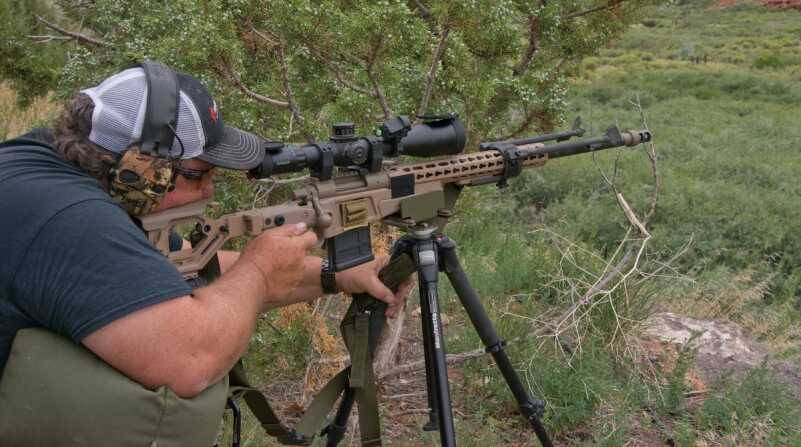
Working the Surgeon during a PRS clinic put on by Marcus Blanchard. It is easy to maneuver even in tight spaces.
I worked with Surgeon Rifles on the project, and they expertly completed the Proof Barrel blank, mating it to the action and adding a PSR brake. All the metal parts were coated in an FDE Cerakote matching the AX-AICS stock provided by Accuracy International. Timney Triggers provided one of their new two stage triggers. Long my preference, this trigger was ordered with a one pound first stage and 2.5 pound second, perfect for combined use. Assembled and test fired, it was shipped with a single five-round AI magazine. Surgeon also provided some of their Nexus Ammunition 136-grain Lapua ammunition.
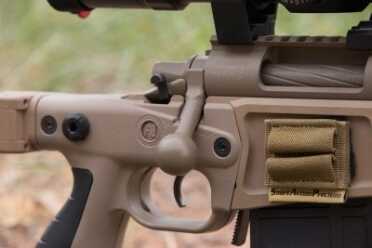
Surgeon’s Scalpel .260 uses an oversized bolt knob perfectly situated for solid and fast manipulation.
SPECS
- Chambering: .260 Rem.
- Barrel: 24 inches
- OA Length: 43.3 inches
- Weight: 10.4 pounds
- Stock: AX–AICS (Accuracy International)
- Sights: 20 MOA rail
- Action: Bolt-action
- Finish: FDE Cerakote
- Capacity: Depends upon magazine type
- MSRP: $5,405 (base rifle price)
Proof Research
Proof Research makes carbon wrapped barrels, but it’s not their only involvement in carbon fiber science. Their Ohio-based division has been devoted to the aerospace and defense industry for years. Building parts for the F-35 Strike Fighter and B2 Stealth Bomber, they are anything but new to mating carbon fiber to other materials. They make and use resins, adhesives, and composite materials that are literally space age; wrapping barrels is just an extension of that science, and one that has been exceedingly difficult over the years. Their Montana facility seems to have cracked that nut as Proof Research Barrels are proving to be excellent.
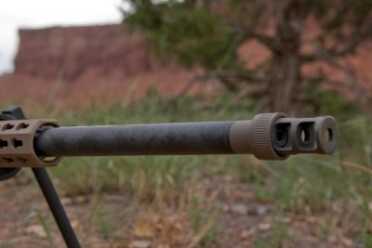
Proof Research barrels offer light weight, durability, and precision accuracy. The PSR brake softens recoil even more.
Every part of the build process is completed in house. Starting with a purpose-built 416R stainless barrel blank, it is contoured to facilitate the carbon fiber application. Applied with proprietary materials and methods, their carbon fiber is applied to each barrel with incredible precision. Their proprietary carbon fiber has a specific strength 30 times that of stainless steel and specific stiffness seven times greater than steel. The wrapping process is designed specifically for rifle barrels. They weigh less, cool faster, and have increased strength and durability without affecting accuracy, consistency, or repeatability. If you are looking to shed weight without compromising accuracy and reliability, Proof barrels are excellent.
Testing
Given this rifle’s emphasis on competing, my Kahles K 624i 4x24x 56mm scope was mounted in a set of Seekins Precision rings. A JEC Customs TLD (Target Locating Device) was added that includes a level. Attaching a Trijicon RMR, it allows you to spot targets at range without turning the magnification up and down. Aadmount scope covers protect the glass. Stronger than any other covers tested they fold flat against the scope. David Tubb’s Distance Reduction Indicator (DRI) was attached for deep angle adjustments. It’s simple with no need for a calculator. Elite Iron’s Revolution Bi-pod provided support. Designed to cradle the rifle it is incredibly stable. It’s strong, and a front ring allows me to drive the rifle into barricades or other barriers for support. It’s one of the most versatile field bi-pods I have ever used. My last addition was the Thor PSR suppressor for some of the testing.

This Federal 142-grain SMK was very accurate in the Proof Research barrel and consistent a distance.
Accuracy
Once broken in, the accuracy with the Scalpel was as expected—impressive. My best group came with my handloads using Berger 130-grain Hybrid bullets. Designed for use in magazine-fed weapons, it allows me to safely get 2,900 feet per second for seriously flat shooting. Every group with this load was under 0.40 inches, with my best measuring right at 0.25 inches. The Nexus ammunition was almost the same at 0.27 inches. Nothing was outside 0.45 inches. This is at the limits of my ability under normal conditions. Over the years I have produced a few five-shot groups that are tighter, but not many, and not in awhile. This rifle is essentially shooting at the limits of the load and the shooter—as good as it gets.
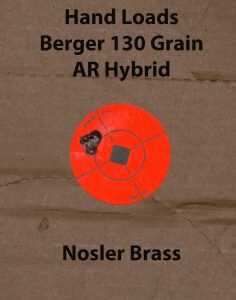
Using hand loaded 130-grain Berger AR Hybrid bullets and Nosler brass, the Surgeon was very scalpel-like with superb accuracy and long-range stability.
Where this rifle really shines is working off the bench or the ground. Moving around barricades and obstacles is a dream. Balance is about perfect, and it is very handy moving it in and out of ports. Used during a PRS (Precision Rifle Series) clinic taught by Marcus Blanchard of Sidewinder Industries, it really shined. A top-tier PRS shooter, his clinics run you through previous matches while he provides insight and training. Marcus’s two-way sidewinder dope card was also used at each stage. Using Federal Gold Medal Match 142-grain SMK, it was deadly accurate. The action was smooth with zero binding, even under stress. Its first test was stellar so I am really looking forward to more.
Back at the home range it proved just as consistent out to 1,000 yards during preliminary testing and truing using Nexus 136-grain ammo. Groups on paper at 300 yards were mostly sub inch with a few in the 1.25-inch range. At 500 yards the group grew to fist sized, so 4 inches or so. My best 10-shot group on the 1,000-yard steel measured in the 8-inch range using the reticle in the scope to measure. Given a still day it may get better, but this rifle is holding accuracy under 1 MOA with ease out to 1,000 yards.
Considerations

AWC’s PSR suppressor was designed for the initial PSR (Precision Sniper Rifle) .338 LM contract. It is very light weight in incredibly quiet.
AWC’s PSR Thor is quiet, very quiet, even as a .338 suppressor on a 6.5mm bore. Impact shift at 100 yards was 2 inches low with no side to side movement. So long as you are not running rapid fire it provided no issues. Speed things up and the bolt lift force required increased considerably. Given the bore difference the first round push was minimal, but back pressure built up pretty quickly. Unlike and AR that immediately unlocks the bolt sending gas out the ejection port, a bolt gun stays locked until you lift the bolt. Wait a bit and it dissipates out the suppressor, otherwise it gets hard to lift the bolt. Suppressors vary; just something to test and be aware of.
The PSR brake works great, so it is loud as expected, but it tames recoil quite a bit. Even using my hand loads it was possible to stay on target and watch for hits, misses and splash where appropriate. It’s painful in tight spaces, but manageable in the open for the shooter.
Final Thoughts
Over the years I have tested and fielded numerous precision rifles. Proof Research barrels are as accurate as any comparable steel counterpart, and more accurate than many. Weight savings on longer barrels is substantial, often measured in pounds. For small carbines not as much, but noticeable. Retail on a bolt-action blank is $900.00, about twice the cost of similar barrels, or more depending on the steel barrel. Threading to the action and muzzle costs the same; installation is identical. Drop-in AR barrels are $940.00, a little more, but the margin is smaller compared to high-end steel barrels that can run $700.00. Probably not something you put in your budget AR build, but worth it on some custom rifles. It really boils down to weight and how critical that is to you. You get the same contour with a longer barrel, still saving a couple pounds in some cases. For some it’s worth every penny when building a high-end custom rifle.

Accuracy International’s AX stock allowed the author to mount the Elite Iron Bi-pod farther to the rear for use on barricades or obstacles. Those teeth bite into wood or other surfaces.
This project took awhile to put together, but it was worth it. Overall weight is minimal; almost light for a precision rifle. Balance is perfect, and the AX stock provides usable adjustments that stayed put. The action is smooth and precise, ejection consistent and positive, and accuracy superb. Given a duty requirement, I would field this rifle in a heartbeat. Loaded in a pack, it carries easily and it will get used on long hikes into the back country. Any limitations on the competition circuit are mine, not the rifle’s. If you are looking for a truly precision rifle, then give the Surgeon Scalpel a solid look. If you want to lighten it up, then a Proof Research barrel should be your first upgrade.
To find out more about Surgeon Scalpel rifles, visit https://surgeonrifles.com/.
To learn more about Proof Research, visit https://proofresearch.com/.
To purchase a Surgeon Scalpel rifle on GunsAmerica.com, click this link: https://www.gunsamerica.com/Search.aspx?T=surgeon%20scalpel.
[one_half]
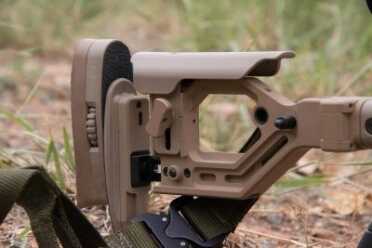
The AX stock allows you to adjust the stock to fit you perfectly. Folded, it locks into place, cradling the bolt and allowing you to fit it into smaller packs and cases.
[/one_half]
[one_half_last]

Surgeon matched the PSR brake to the Proof Research barrel perfectly. It tames recoil and will accept the AWC PSR .338 Suppressor for quiet operation.
[/one_half_last]

The moderator on the XM177 or the GAU 5/A created a small amount of back pressure so the rifle would work properly, Without it some guns would not function due to the small, less than.065 gas port. All suppressors create a small amount.
One of my good friends just bought for himself a fancy and fast BMW sports car; low slung, sleek, black and a spitfire when you punch it.. I just bought a heavy-duty Chevy extended cap pick-up truck, 4×4, of course.. My mechanic says I can now tow a travel trailer that my wife and I have on order but that we’ll have to keep looking into the rearview mirror to make sure that it’s still really there.. The purpose of this point? Both vehicles have four wheels and an engine that we get each of us to where we want to go but it will be done in different styles… I’m not about to begrudge another who wants to spend more than $5,000 for a supremely accurate rifle that will no more make dead an antelope on the wide open prairie than will one costing a fifth that amount. As it’s said in French: “viva la difference!”
I shoot, drive nice cars, and cook, largely because I love to eat. In the kitchen I have no problem spending several hundred dollars for a nice, single pan, and several hundred for a nice knife. Pans cook and knives cut. Are they all alike? Hardly. Your justification of your spending less, insinuating that the other guy spent more and didn’t get more in return sounds like class envy and wallows in ignorance. When art and engineering meet, there is a price. You may not be willing to pay that price and that is your right.
appreciate the info re: the cool stuff on this rifle setup, but as a review, I think it lacks some important details — or at least clarification of same. What was the overall weight of the rig as you show it (i.e. with bipod, scope)? How many groups did you shoot (and how many shots in each) to determine your sub-0.40″ accuracy? (For my money, you gotta follow the American Rifleman protocol of five consecutive 5-shot groups, ideally with at least three kinds of ammo…)
How much did the overall setup cost?
For perspective, I have a .308 factory Rem 700 VSSF (circa 1995) in original condition, although I adjusted the trigger pull weight to 2.25 lbs. Equipped with a Sightron 4-16×42 mildot scope in Millet rings on two-piece standard (Redfield style) Leupold bases, and a Harris BRM-S bipod, the whole rig weighs 10.5 lbs. with 4 rounds in the BDL type magazine. It is easily capable of sub-MOA groups all the way to 1,000y, albeit Federal Gold Medal Match is necessary for shooting past 600y (to which distance FGMM 168 is excellent, but fades badly thereafter…). Total cost of the setup (admittedly in late ’90s dollars)? About $1k. I wouldn’t sell it for twice that; it/I have won several tactical/long range matches together. But it looks like an antique compared to the setup in the review above.
$5405.00 base price MSRP? I will just stay with my M14! If not an M14 then I am sure there are others which shoot just as well for a much lower price point. But, hey if one has that kind of disposalble income? Go for it!
Yup…..toys that push beyond the financial envelope and for most commonsense are unnecessary.
I thot this thru in the early 90’s realizing buying more, spending more can be an expensive trap and a rut.
So pursued the best all around hand built quality rifle that could be bought cheap; a cartridge and caliber that is the epitome of efficiency + can do it all(and has).
It came down to the surplus Swedish 96’s + 38’s in 6.5×55. Can’t be beat for accuracy(optics, ammo+shooter-?) as well as gallery ammo $70 for 1440rds for plinking(tho will pass thru a 2×4 at close range).
These rifles have killed countless moose, caribou, Brown+Polar bears in the Scandinavian countries.
The sectional density of and ballistic coefficiency is supreme and the 6.5 was the first round to do a complete pas thru of mature African bull elephants skulls a 100+yrs ago. Not that I’d wanna shoot one- only an interesting fact.
The Swede doesn’t need hyper velocity as it has the fastest twist of any rifle made(probably equaled now @ 1 in 7.9) so barrels don’t burn out nor recoil present a problem.
I saw the relevant value in this then- the U.S. military is finally up for the 6.5.
The eqivalent of the M14 is the Swedish AG 42 Ljungman in 6.5×55 semi is nice too(1942). This design was the chosen forunner to the original U.S. Armalite and French MAS 49.
The Swedes were once a smart capable people but went liberal/socialist and are now overrun with raping Muslem’s- like Hil-liar-y. wants here and Europe already does.
MAO’bama is flying them in regularly now- may God help America now.
WE definitely need people vote Trump and the Conservative ticket line ~!
Supressors do not create back pressure buildup in a barrel. They also will not change point of impact of a projectile. If your bullet drop was 2 inches then you have a missaligned supressor and should not be using it. You could hurt youself.
Uh Kev? You are a little beyond your depth here, buddy. A suppressor can most certainly change POI. That is why consistent timing is so critical on suppressed precision rifles.
seems that is exactly what he is eluding to, it not being aligned, you need a remedial reading course!!!!!!!!!!!!!!!
Gary,
Alluding, eluding… tomato, tomahto… but not quite.
Eluding is evasion. escape, while alluding is verbal suggestion. I got what you were alluding to, but if you are criticizing another you shouldn’t elude the scrutiny you measure others by. I understand there are a lot of remedial courses in the use of the English language if you are so inclined.
Too flipping funny! Perfect case of bricks and glass houses.
I think what I am alluding to, is that you need a remedial spelling course…
Hanging 16 oz on the end of your barrel will shift your POI.
Putting something out there on your barrel will certainly shift POI, but I had a problem with their description of the pressure in the barrel. They’re acting as if the greater exertion needed to lift the bolt is due to existing pressure in the barrel and if one waits for it to dissipate, it will become easier. How long do you suppose that pressure is in the barrel with a huge hole in the end for it to escape? Milliseconds at most? Who could possibly be so fast as to fire and attempt to lift the bolt in that instant when there is pressure in the barrel? Did I badly misunderstand something there?